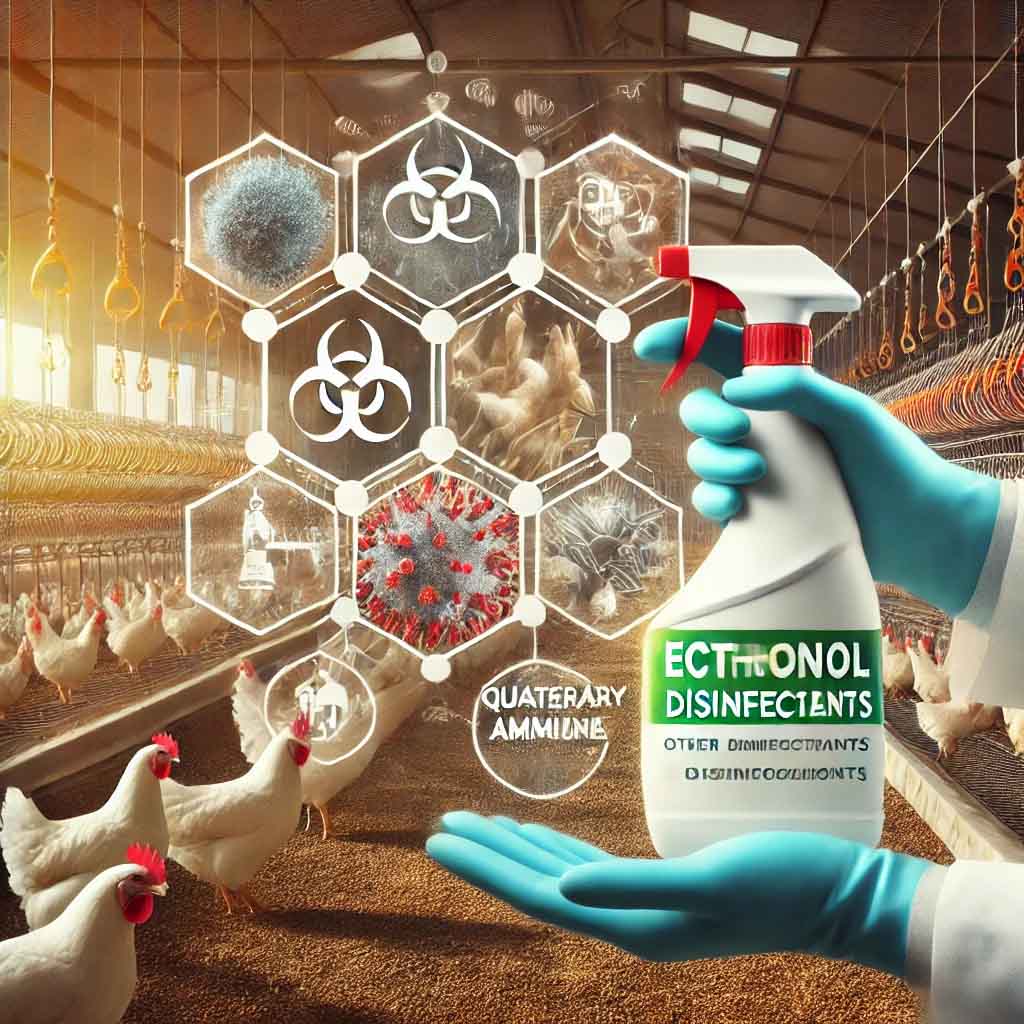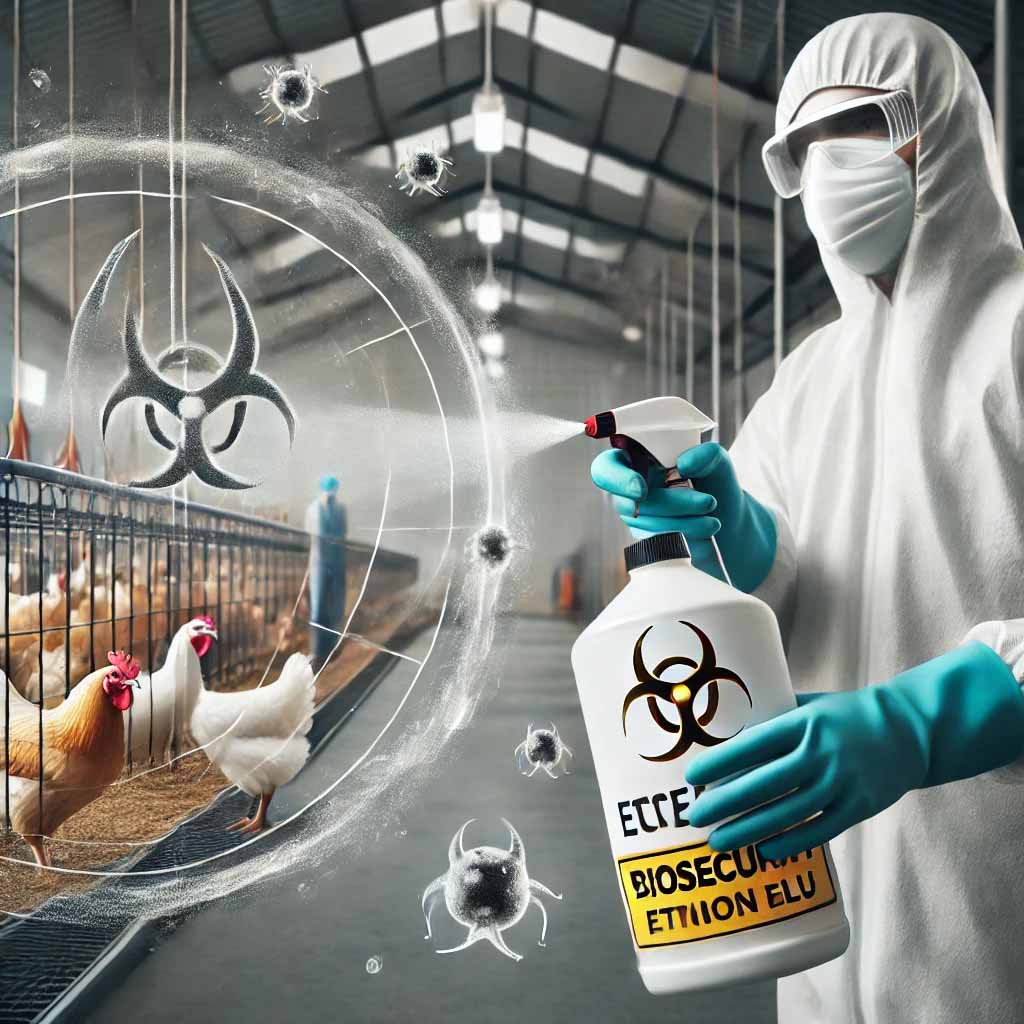Ethanol stands as a powerful defense against viral outbreaks, breaking down pathogens before they can spread. Using ethanol to prevent the bird flu has become a key strategy in controlling infections, especially in poultry farms and high-risk environments. As a strong disinfectant, ethanol effectively destroys the lipid membrane of avian influenza viruses, reducing their ability to survive on surfaces. Regular disinfection of equipment, enclosures, and hands using ethanol-based solutions helps minimize transmission risks. Beyond farms, using ethanol to prevent the bird flu also plays a role in biosecurity protocols for transportation and food processing. We explore the effectiveness of ethanol in preventing bird flu, its applications in poultry farming, and its role in global disease control efforts.
Click to use Silverigroup personal shopper services
Ethanol’s Role in Combating Bird Flu
Ethanol, commonly used in disinfectants, is effective against the bird flu virus due to its ability to disrupt the virus’s structure. Bird flu, caused by the avian influenza virus (H5N1), has a lipid-based envelope that protects its genetic material. Ethanol, a type of alcohol, works by breaking down the lipid layer, rendering the virus incapable of infecting host cells.
When ethanol comes into contact with the virus, it penetrates and damages the lipid bilayer, destabilizing the viral particles. This process inactivates the virus, preventing it from spreading or causing illness. Ethanol concentrations between 60% and 90% are considered optimal for disinfection because they balance the ability to penetrate the viral envelope while avoiding the excessive evaporation that would reduce efficacy.
Click to buy citric acid from Silvairgroup
Additionally, ethanol is non-toxic and fast-acting, making it an ideal agent for cleaning surfaces in environments where bird flu is a concern, such as farms and poultry processing plants. Using ethanol-based sanitizers can help control the spread of the virus, protecting both animal and human health.

Using Ethanol for Disinfection in Poultry Farms
Ethanol is a powerful disinfectant that effectively eliminates bacteria and viruses from farm surfaces and equipment. Its rapid action and residue-free properties make it a reliable choice for poultry sanitation. In the following sections, we explore key applications of ethanol in poultry farms, including its role in disinfecting housing, water systems, hatchery equipment, feed storage, and transport vehicles.
Click to buy Beluga Fresh Frozen from Silverigroup
1. Using Ethanol to Disinfect Poultry Housing and Equipment
Poultry housing and equipment are prime areas where bacteria and viruses can thrive. Regular disinfection with ethanol helps eliminate pathogens from surfaces such as walls, floors, and feeding stations. Ethanol’s effectiveness comes from its ability to break down the lipid membranes of viruses, including avian influenza, reducing the risk of infection among birds. Equipment such as feeders, drinkers, and nest boxes must be disinfected frequently to prevent cross-contamination. Farmers can apply ethanol-based solutions using sprayers or wipes to clean surfaces efficiently. Since ethanol evaporates quickly and leaves no toxic residue, it is safe for use in poultry environments. However, proper ventilation is necessary to prevent excessive inhalation by workers and birds.
2. Ethanol for Cleaning Water Systems in Poultry Farms
Contaminated water sources can be a major cause of disease outbreaks in poultry farms. Bacteria, fungi, and viruses can multiply in water lines, tanks, and drinkers, compromising the health of the flock. Ethanol is an effective disinfectant for cleaning water distribution systems, ensuring that birds have access to clean drinking water.
Farmers can use diluted ethanol solutions to flush water pipes and storage tanks, eliminating biofilm buildup and microbial contamination. Unlike some chemical disinfectants, ethanol does not leave harmful residues in the water, making it a safe option for poultry farming. Regular maintenance and disinfection of water systems with ethanol can significantly reduce the spread of waterborne diseases and improve overall flock health.
3. Disinfecting Incubators and Hatchery Equipment with Ethanol
Hatcheries are highly sensitive environments where newly hatched chicks are vulnerable to infections. Bacteria and viruses can easily spread through incubators, egg trays, and other hatchery equipment if proper hygiene measures are not in place. Ethanol serves as an ideal disinfectant for hatchery sanitation due to its rapid antimicrobial action and non-toxic nature. Before placing new eggs in incubators, surfaces should be wiped down with ethanol-based disinfectants to kill any lingering pathogens. Egg-handling equipment, including trays and transport containers, should also be sanitized to prevent the spread of infections among hatchlings. Since ethanol dries quickly and does not leave harmful residues, it ensures a clean and safe environment for chick development.
4. Sanitizing Feed Storage and Distribution Areas with Ethanol
Feed storage and distribution areas can become breeding grounds for mold, bacteria, and pests if not properly maintained. Contaminated feed poses a serious health risk to poultry, leading to disease outbreaks and reduced productivity. Ethanol is a valuable tool for sanitizing feed storage rooms, bins, and transport containers, preventing the growth of harmful microorganisms. Applying ethanol-based disinfectants to feed storage surfaces helps eliminate bacteria and mold spores that can contaminate poultry feed. Additionally, cleaning feed distribution equipment, such as conveyors and feed troughs, with ethanol ensures that birds receive uncontaminated nutrition. Regular sanitation of these areas supports better flock health and minimizes the risk of disease transmission through feed.
5. Using Ethanol for Biosecurity in Transport Vehicles
Poultry transport vehicles are another critical area where diseases can spread between farms. Trucks, crates, and cages used for transporting birds can harbor viruses and bacteria if not properly disinfected. Ethanol-based disinfectants provide a reliable solution for sanitizing transport equipment and reducing biosecurity risks.
After each transport cycle, vehicles should be thoroughly cleaned with ethanol to eliminate any pathogens left behind by previously transported birds. Spraying ethanol on surfaces such as loading ramps, crates, and door handles ensures a clean environment for the next batch of poultry. Since ethanol evaporates quickly, it allows for fast disinfection without prolonged downtime for vehicles.
Comparing Ethanol with Other Disinfectants for Bird Flu Prevention
Ethanol is widely used for disinfecting surfaces and preventing the spread of viruses like bird flu (H5N1). However, there are several other disinfectants available that also target avian influenza. To understand which is most effective, it’s important to compare ethanol with other common disinfectants like bleach (sodium hypochlorite), hydrogen peroxide, and quaternary ammonium compounds.

Ethanol
- Mechanism: Ethanol works by disrupting the lipid envelope surrounding the bird flu virus, rendering it inactive and preventing it from infecting host cells.
- Effectiveness: Concentrations of 60% to 90% ethanol are effective at inactivating the virus. It penetrates the viral envelope, disrupting its structure.
- Pros:
- Fast-acting.
- Non-toxic to humans when used correctly.
- Widely available and easy to use.
- Cons:
- Evaporates quickly, which can reduce its effectiveness if not applied properly.
- May not work well on certain porous surfaces like wood or fabric.
Bleach (Sodium Hypochlorite)
- Mechanism: Bleach is a strong oxidizing agent that damages the protein structure and genetic material of viruses, inactivating them.
- Effectiveness: Bleach is highly effective against bird flu and other viruses, even at relatively low concentrations (0.1-0.5%).
- Pros:
- Highly effective on a wide range of viruses and bacteria.
- Works well on various surfaces, including porous ones like fabric.
- Cons:
- Harsh chemical; can be toxic if not diluted properly.
- Strong odor and potential for skin irritation.
- Requires longer contact time compared to ethanol.
Hydrogen Peroxide
- Mechanism: Hydrogen peroxide works as an oxidizing agent, breaking down the viral proteins and lipids, leading to viral inactivation.
- Effectiveness: Hydrogen peroxide (usually 3%) is effective against bird flu and can be used on a variety of surfaces.
- Pros:
- Non-toxic and generally safe when used in recommended concentrations.
- Effective on multiple surfaces, including hard-to-reach areas.
- Cons:
- Less effective on highly contaminated surfaces compared to ethanol and bleach.
- Can cause material degradation (e.g., discoloration of fabrics).
Quaternary Ammonium Compounds (Quats)
- Mechanism: Quats act by disrupting the viral cell membrane and proteins, rendering the virus non-infectious.
- Effectiveness: Quats are effective against a broad range of pathogens, including avian influenza, and are often used in commercial disinfectants.
- Pros:
- Effective at low concentrations.
- Typically safer for human contact compared to bleach.
- Cons:
- Less effective in the presence of organic matter (dirt, blood, etc.).
- May require longer contact time.
| Disinfectant | Benefits |
| Ethanol | Fast-acting, non-toxic, effective on hard, non-porous surfaces. |
| Bleach | Broad-spectrum effectiveness, works on various surfaces. |
| Hydrogen Peroxide | Safer, non-toxic, works on multiple surfaces. |
| Quats | Effective, safer, works on various surfaces. |
For bird flu prevention, the choice of disinfectant should be based on surface types, exposure time, and safety considerations. A combination of disinfectants may also be necessary to ensure thorough decontamination.
Economic and Environmental Impact of Ethanol in Bird Flu Prevention
Ethanol is widely used as a disinfectant to control the spread of bird flu, but its economic and environmental implications are important to consider.
Economic Aspects:
- Cost-Effective: Ethanol is relatively inexpensive compared to other disinfectants like bleach or quaternary ammonium compounds, making it accessible for widespread use in farms and poultry industries.
- Availability: Ethanol is widely available, ensuring its ease of access in regions affected by bird flu outbreaks.
- Labor Costs: Due to its fast-acting nature, ethanol reduces the time required for disinfection, potentially lowering labor costs.
Environmental Aspects:
- Biodegradable: Ethanol is biodegradable and less harmful to ecosystems compared to more toxic chemicals like bleach. It does not leave long-lasting residues in the environment.
- Carbon Footprint: While ethanol is derived from renewable sources like corn and sugarcane, large-scale production can contribute to land use changes and emissions, which may increase its carbon footprint.
- Volatility: Ethanol’s quick evaporation rate may contribute to air pollution, though its low toxicity means it poses less risk to human health and wildlife compared to other disinfectants.
In conclusion, ethanol offers both economic and environmental benefits but must be used with consideration of its production and emissions impact.
Challenges and Limitations of Using Ethanol
Using ethanol for bird flu prevention comes with several challenges and limitations. One key issue is its quick evaporation rate, which reduces its effectiveness if not applied properly or if surfaces dry too quickly. This requires frequent reapplication, especially in environments with high airflow or heat. Additionally, ethanol is most effective on hard, non-porous surfaces, but its efficacy decreases on porous materials such as fabrics, wood, or dirt, which are common in poultry farms.
Another limitation is that ethanol does not provide long-lasting protection. Once it evaporates, surfaces may become re-contaminated. Ethanol’s potential to contribute to air pollution is another concern, as its volatile nature can lead to the release of fumes into the environment. Ethanol is also flammable, which presents safety risks during storage and handling, especially in large quantities. While it is effective against the bird flu virus, its relatively high cost compared to other disinfectants in large-scale operations may pose financial challenges for some producers. Finally, overuse of ethanol could contribute to the development of resistance in certain pathogens, though this is less common with viruses like bird flu.
Conclusion
In conclusion, ethanol is an effective and widely used disinfectant for preventing the spread of bird flu, particularly due to its ability to rapidly inactivate the virus. While it offers advantages such as low toxicity, cost-effectiveness, and biodegradability, it also has limitations, including quick evaporation, reduced effectiveness on porous surfaces, and potential safety risks due to its flammability. To maximize its benefits, proper application and consideration of environmental factors are essential. Overall, ethanol remains a valuable tool in bird flu prevention, but its use should be complemented by other measures for comprehensive control.

